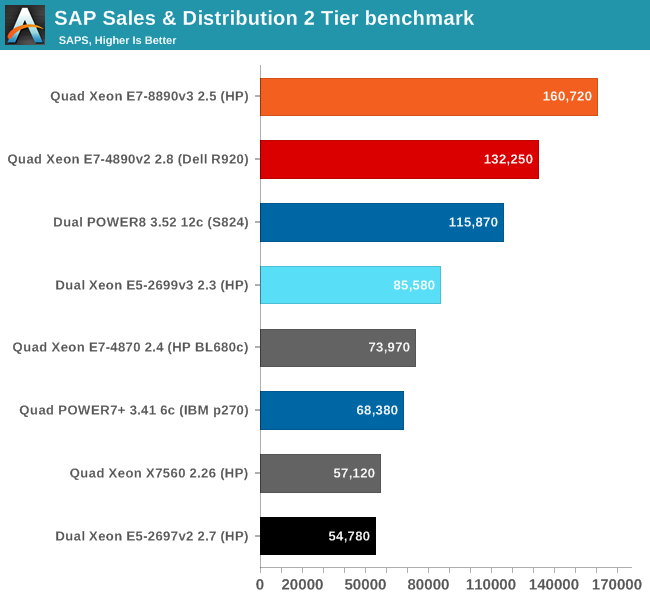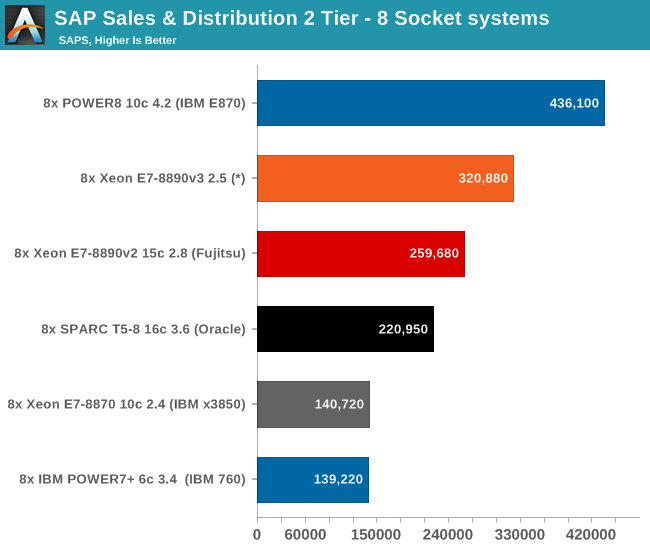The Intel Xeon E7-8800 v3 Review: The POWER8 Killer?
by Johan De Gelas on May 8, 2015 8:00 AM EST- Posted in
- CPUs
- IT Computing
- Intel
- Xeon
- Haswell
- Enterprise
- server
- Enterprise CPUs
- POWER
- POWER8
SAP S&D Benchmark
The SAP SD (Sales and Distribution, 2-Tier Internet Configuration) benchmark is an interesting benchmark as it is a real-world client-server application. It is one of those rare industry benchmarks that actually means something to the real IT professionals. Even better, the SAP ERP software is a prime example of where these Xeon E7 v2 chips will be used. We looked at SAP's benchmark database for these results.
Most of the results below all run on Windows 2008/2012 and MS SQL Server (both 64-bit). Every 2-Tier Sales & Distribution benchmark was performed with SAP's latest ERP 6 Enhancement Package 4. We analyzed the SAP Benchmark in-depth in one of our earlier articles. The profile of the benchmark has remained the same:
- Very parallel resulting in excellent scaling
- Low to medium IPC, mostly due to "branchy" code
- Somewhat limited by memory bandwidth
- Likes large caches (memory latency)
- Very sensitive to sync ("cache coherency") latency
Let's see how the quad Xeon compares to the previous Intel generation, the cheaper dual socket systems, and the RISC competition.

When we said that the competition in the high-end market was heating up, we were not kidding. The dual socket (24-core) S824 beats the dual socket Xeon E5 by a large margin (+35%), despite the latter having 50% more cores (36 vs 24).
At IBM's website, this server is priced at $65k, but the actual street prices are around $35k, slightly below what a typical similar quad Xeon costs (around $40k) .Of course, IBM should make it easier for small enterprises to get their hardware quickly at a decent price. But this shows that it is not impossible that POWER servers can become an alternative to the typical x86 systems... just not from IBM's webstore. The POWER8 system might be somewhat cheaper to acquire than the HP DL580 Gen9, but that Intel system is still almost 40% faster, so IBM is not an alternative quite yet. Then again, IBM is a lot more competitive than a few years ago. The S824 is not that far behind the Quad Xeon E7 v2, so it is a good thing that the new Xeon E7 offers about 20% better performance than the latter.
So who is on the top of server foodchain?

They might be power hungry, but the new POWER8 has made the Enterprise line of IBM more competitive than ever. Gone are the days that IBM needed more CPU sockets than Intel to get the top spot. Nevertheless, it should be noted that you can get several 8-socket Xeon systems for the price of one IBM E870 enterprise server.










146 Comments
View All Comments
DanNeely - Friday, May 8, 2015 - link
Intel's 94% market share is still only ~184k systems. That's tiny compared to the mainstream x86 market; and doesn't give a lot of (budgetary) room to make radical changes to CPU vs just scaling shared designs to a huger layout.theeldest - Friday, May 8, 2015 - link
184k for 4S systems. The number of 2S systems *greatly* outnumbers the 184k.Samus - Sunday, May 10, 2015 - link
by 100 orders of magnitude, easily.2S systems are everywhere these days, I picked up a Lenovo 2S Xeon system for $600 NEW (driveless, 4GB RAM) from CDW.
4S, on the other hand, is considerably more rare and starts at many thousands, even with 1 CPU included.
erple2 - Sunday, May 10, 2015 - link
Well, maybe 2 orders of magnitude. 100 orders of magnitude would imply, based on the 184k 4S systems, more 2S systems than atoms in the universe. Ok, I made that up, I don't know how many atoms are in the universe, but 10^100 is a really big number. Well, 10^105, if we assume 184k 4S systems.I think you meant 2 orders of magnitude.
mapesdhs - Sunday, May 10, 2015 - link
Yeah, that made me smile too, but we know what he meant. ;)evolucion8 - Monday, May 11, 2015 - link
That would be right if Intel cores are wide enough which aren't compared to IBM. For example, according to this review, enabling two way SMT boosted the performace to 45% and adding two more threads added 30% more performance. On the other hand, enabling two way SMT on the latest i7 architecture can only go up to 30% on the best case scenario.chris471 - Friday, May 8, 2015 - link
Great article, and I'm looking forward to see more Power systems.I would have loved to see additional benchmarks with gcc flags -march=native -Ofast. Should not change stream triad results, but I think 7zip might profit more on Power than on Xeon. Most software is not affected by the implied -ffast-math.
close - Friday, May 8, 2015 - link
It reminds me of the time when Apple gave up on PowerPC in mobiles because the new G5s were absolute power guzzlers and made space heaters jealous. And then gave up completely and switched to Intel because the 2 dual core PowerPC 970MP CPUs at 2.5GHz managed to pull 250W of power and needed liquid cooling to be manageable.IBM is learning nothing from past mistakes. They couldn't adapt to what the market wanted and the more nimble competition was delivering 25-30 years ago when fighting Microsoft, it already lost business to Intel (which is actually only nimble by comparison), and it's still doing business and building hardware like we're back in the '70s mainframe age.
name99 - Friday, May 8, 2015 - link
You are assuming that the markets IBM sells into care about the things you appear to care about (in particular CPU performance per watt). This is a VERY dubious assumption.The HPC users MAY care (but I'd need to see evidence of that). For the business users, the cost of the software running on these systems dwarfs the lifetime cost of their electricity.
SuperVeloce - Saturday, May 9, 2015 - link
They surely care. Why wouldn't they. A whole server rack or many of them in fact do use quite a bit of power. And cooling the server room is very expensive.